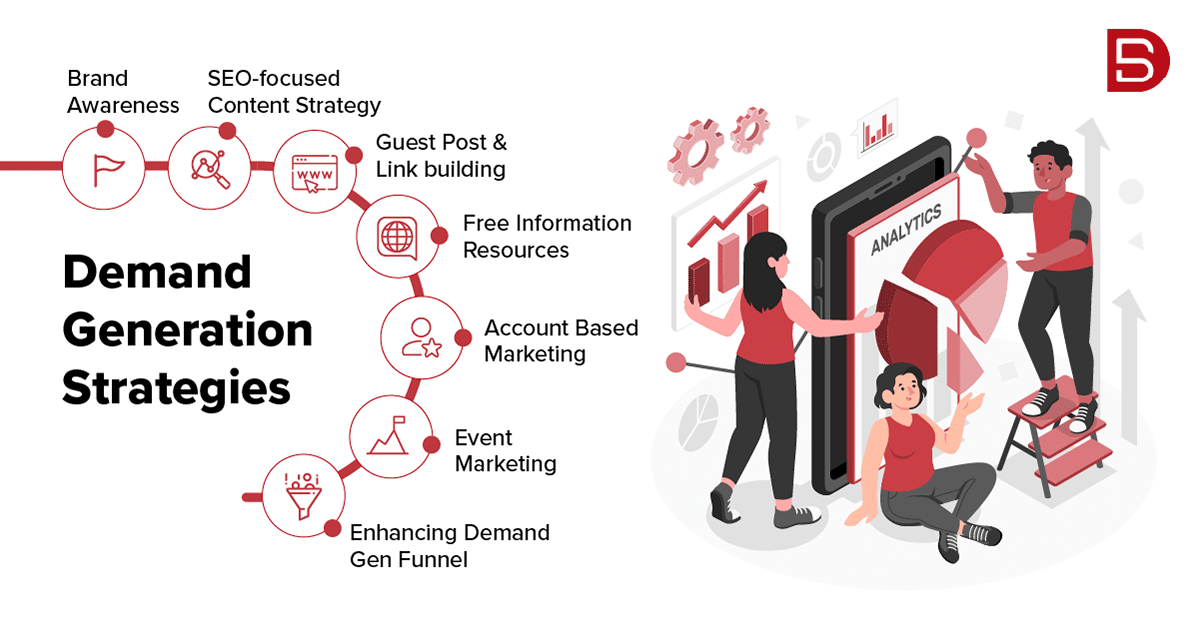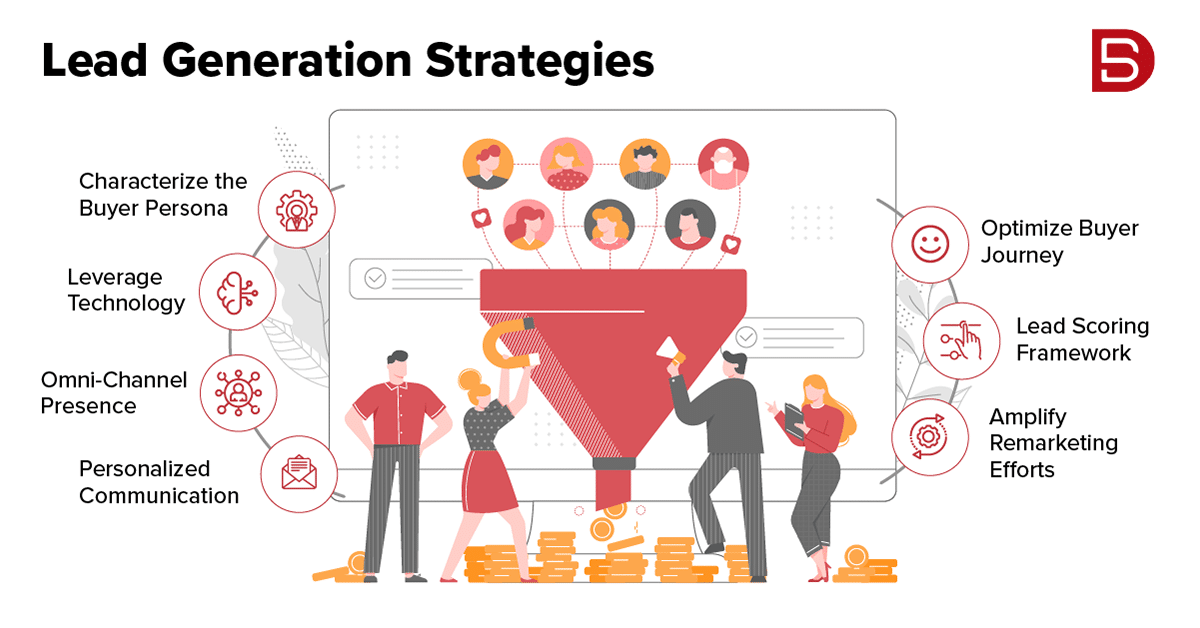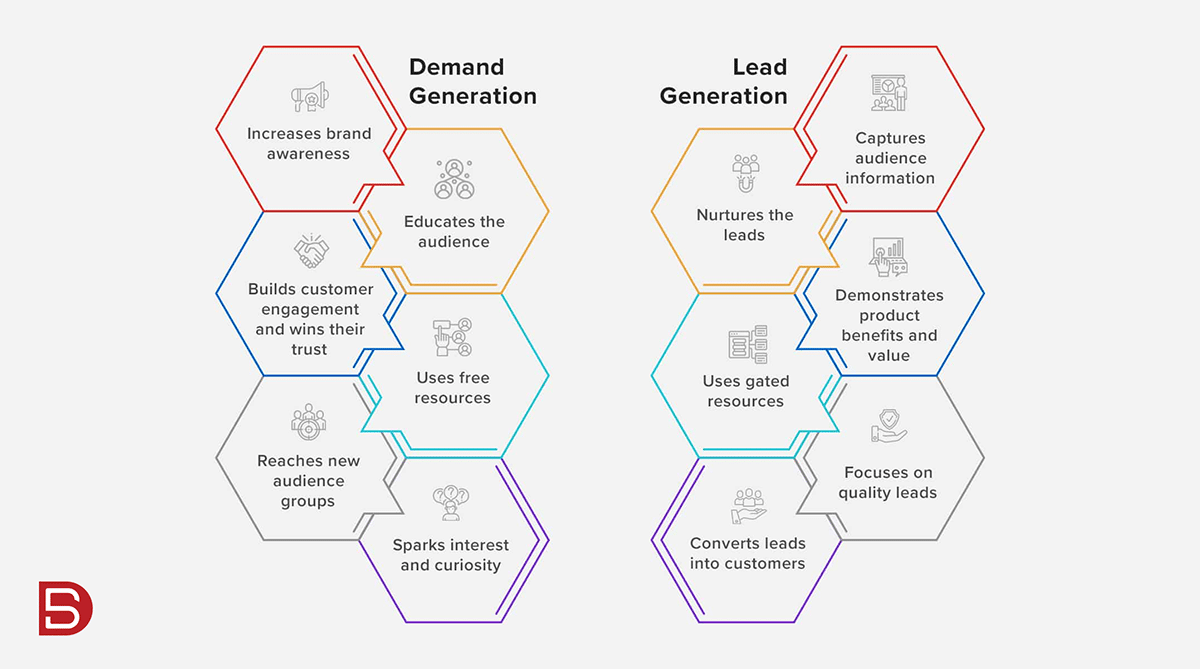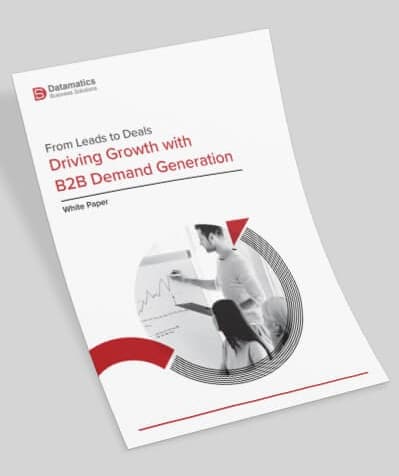Every marketing team aims for demand generation for their products and services in the long run. Today, customers expect easy access to all the information they need to make the buying decisions. Sales & marketing campaigns should cater to this need and serve as a medium to educate the audience about everything there is to know about your products and services.
This is exactly where demand generation vs lead generation become a critical aspect of marketing strategies. Although they are often used interchangeably, there is a huge contrast between the two practices.
 Select an element to maximize. Press ESC to cancel.
Select an element to maximize. Press ESC to cancel.What is B2B Demand Generation?
Demand generation is the process of creating brand awareness and educating people about your product and service offerings. As the name suggests, B2B demand generation is all about creating demand for your business. Marketers aim to expand their business audience, create buzz about their brand and drive traffic to their website and social media platforms.
B2B demand generation is a data-driven and a well-orchestrated strategy that marketers leverage to generate awareness. It is crucial to identify and understand the needs, expectations and problems of your audience. This will help you educate them regarding how your business is an ideal solution for them through marketing communication and campaigns.
The important aspect of demand generation is that the content is mostly free for the audience. The objective of the content is to inform and educate them. This can span across website content, blogs, industry portals and also social media presence.
What are Demand Generation Strategies?
1. Building Brand Awareness
With a plethora of service providers in the market, you need to stand out amongst your competitors with your demand generation strategies. Your business offerings should be able to garner the attention of potential buyers. Here, brand awareness becomes critical. An effective and long-lasting brand awareness strategy should leave potential buyers with a positive impression of your business and win their trust.
2. Developing a SEO-focused Content Strategy
Creating SEO-friendly content can improve your search rankings, increase your website traffic, and create strong authority among your audience. People often prefer to visit top ranked pages on search engines. Optimizing your content with the right intent keywords and high-quality content will help you boost your SERP ranking.
3. Guest Posts and Off-page SEO
Marketers who are looking to improve their search engine rankings for effective demand generation should not ignore off-page SEO. Your demand generation strategies must include guest posting programs where you collaborate with high-authority websites to share your content. Guest posting is the best way to expand your audience reach and one of the most effective demand generation strategies.
4. Offering Free Information Resources
One of the most effective ways to educate prospects about your products and services is through providing free content resources. This is a proven way for demand generation. The more information buyers have, the more informed decision they can make. Also, the quality of your content has a direct impact on customers’ perception of your business.
5. Implement Account-Based Marketing (ABM)
Account-based marketing (ABM) is a strategy that focuses on smaller groups of prospects or even individual accounts. It is highly effective for scalable business development and revenue growth, as it tailors solutions precisely to address the unique pain points of each account, thereby creating demand.
This approach enables businesses to consolidate their resources and efforts to create personalized marketing and sales strategies. The primary objective is to drive engagement, particularly among high-value accounts.
To harness ABM effectively, your company must leverage high-quality data to curate a list of qualified target accounts. Your marketing and sales teams collaborate to direct their efforts toward these selected accounts, delivering personalized content and tailored messages.
The beauty of account-based marketing is that it brings you closer to identifying the right contacts within a company, allowing you to deliver messages of higher relevance and value to your customers. This focused approach can significantly enhance your engagement with key accounts.
6. Establish Authority Through Event Marketing
Event marketing stands out as a highly efficient and results-driven method for elevating brand awareness and increasing credibility. In fact, according to a report by Forbes, 70% of marketers consider live events to be pivotal in achieving marketing success for businesses. This strategy empowers you to maintain direct, in-person interactions with your audience, offering timely solutions.
The biggest pro to event marketing is that it doesn’t necessarily require participation in the largest events. Smaller, more intimate gatherings can often be more effective in helping your brand stand out. They provide an opportunity for genuine interaction with your audience. If resources permit, you can even host your own events.
By leveraging event marketing, your company can cultivate trust and foster brand loyalty, making a profound impact on your audience. This approach is a key driver in building authority and solidifying your position in the market.
7. Enhance Your Demand Funnel Framework
Employing a well-structured demand generation funnel as your guide can offer you a clear and comprehensive view of the distinct stages in the customer journey. This demand generation strategy allows you to gain insights into the entire customer experience, starting from their initial encounter with your brand and leading up to the moment they decide to make a purchase.
A valuable approach is to refine your framework by segmenting it into four key stages — discovery, engagement, conversion, and reward. However, it’s important to note that there is no one-size-fits-all formula for demand generation strategies. Your approach should be crafted specifically to align with your brand, your audience, and the unique products and services you provide.
What is B2B Lead Generation?
Lead generation is simply the progression of your demand generation strategies. The efforts often include moving a prospect from information discovery phase to a potential sale or sign-up. Lead generation further builds on the awareness and interest developed in the demand generation stage and moves the prospect into the sales funnel.
B2B lead generation is primarily about enhancing customer engagement and interest in your offerings through nurturing leads, establishing connections and engaging with them. This increases the chances of conversion. Usually, businesses use gated content to capture lead information and add the user to the sales funnel for further follow-ups.
What are Lead Generation Strategies?
1. Characterize the Buyer Persona
Identifying your target audience and creating an ideal customer profile (ICP) will prove quite helpful in generating relevant and high-quality business leads. Understanding your buyer persona helps you understand your customers’ problems and expectations better. This leads to effective marketing communication.
2. Leverage Technology
Organizations can leverage smart technology to streamline lead capturing, tracking and nurturing process. AI, RPA, ML and other intelligent technologies can make the lead generation process simple and effective. AI-powered B2B lead generation tools can help you gain valuable insights into the factors that influence buying behavior and leverage these insights to make your marketing campaigns impactful.
3. Build Omni-Channel Presence
Deploying a multichannel marketing strategy helps you create more leads. Multichannel lead generation strategy ensures that you don’t miss out the audience that could be missed in a single channel strategy. You can easily boost your brand visibility and secure both online and offline presence for your business.
4. Personalized Communication
It is important to establish a genuine connection with your target audience. This is where personalizing your B2B lead generation strategies come in handy. Personalized communication makes it easy to appeal to customer needs, desires and personal interests.
5. Optimize Buyer Journey
Customers have certain expectations, and it is of utmost importance that businesses understand and meet those expectations. They should be provided with apt information about your business offerings at every stage of their buying journey.
This can be done through eBooks, whitepapers, How-to-Guides and other forms of gated content. From discovery to conversion, the entire journey should be optimized with mechanisms to provide relevant and helpful content and support.
6. Create a Lead Scoring Framework
A lead scoring framework is a valuable tool to help you rank your incoming leads, emphasizing the level and quality of their interaction.
7. Amplify Your Remarketing Efforts
Remarketing empowers you to maintain a connection with your website visitors, reintroducing your brand to them on various online platforms. For instance, you can focus on reaching out to individuals who’ve explored your website through social media ads.
Remarketing serves as a powerful method to recapture the interest of potential leads, extend enticing offers, and acquire their information to convert them into actionable prospects.
The Ultimate Lead Generation Blueprint for B2B Marketers
Discover proven strategies inside
Download the eBook
Demand Generation vs Lead Generation: Know the Key Differences
As discussed earlier in this blog, demand generation focuses on creating brand awareness and educating the audience about your products and services. Whereas lead generation focuses on converting prospects into qualified leads that are furthered to become customers.
Lead generation depends solely on your demand generation strategies to create more sales conversions. On the contrary, demand generation can act independent of lead generation and focus on creating buzz about the business. It is used to penetrate new audience groups while lead generation is used to convert existing prospects into customers.
Creating demand is at the top of the funnel and it introduces the prospect to the business and includes them into the buying process. On the other hand, lead generation takes place once the prospect passes through the top funnel and shows enough interest in your products and services.
Navigating Demand Generation Vs. Lead Generation Prioritization
As a B2B marketer, it’s crucial to find the right balance between demand and lead generation. To make that decision, consider these three key factors:
1. Goals & Timing:
First, you should have a clear understanding of your goals and the timeframes you’re working with. If you need quick results and are targeting those who are already in the market for your product or service, then lead generation is the way to go. It’s like a sprint to generate leads for a well-established software solution or to convert prospects for newly launched services.
On the other hand, if your aim is to expand your reach and increase awareness, then demand generation is the choice. This approach is perfect for startups looking to get on people’s radars or established companies introducing a unique service that’s yet to be discovered. So, decide based on your objectives and deadlines.
2. Choosing Channels & Content Strategy:
It’s essential to recognize that different objectives call for different channels and content strategies.
When it comes to B2B lead generation, your focus should be on creating conversion-driven content. This content is designed to capture readers’ attention and prompt them to take specific action, such as filling out a form, subscribing to a newsletter, or opting in for emails.
To reach those ready to make a purchase, leverage paid ad channels like search engine marketing. Additionally, highlight content that showcases social proof, demonstrating the success of your customers. Most importantly, ensure your writing is compelling and includes strong calls to action.
In contrast, demand generation content aims to subtly establish your brand in the minds of prospects and position you as a trusted authority in your industry. This involves thought leadership material, social sharing, word-of-mouth recommendations, and organic reach to attract new customers. It’s about building long-term relationships and nurturing brand awareness.
3. Measuring Metrics:
Since lead generation and demand creation have different objectives, the metrics used to evaluate their effectiveness differ.
Lead generation success is often gauged by the quantity and quality of leads generated. Key metrics include tracking the cost per lead, conversion rates, the number of form submissions, and sign-ups for free trials.
On the other hand, demand generation metrics focus on brand interaction and visibility. The effectiveness and overall impact of your campaign are reflected in metrics such as website traffic, the reach of your social media efforts, the number of content downloads, customer loyalty, and levels of prospect engagement. These metrics are all about establishing brand presence and nurturing lasting relationships.
How to Make Demand Generation & Lead Generation Work Together for your Business?
It’s true that both demand generation and lead generation serve the goal of increasing business revenues. But it would be incorrect to say one is more important than the other. In fact, for successful and efficient business growth strategies, it is crucial to have effective demand gen and lead gen strategies working together.
Without a solid demand generation strategy, your sales team will lack the volume of leads and miss out on increasing sales conversions. Before the lead enters the sales funnel, it is necessary to make it aware about your business and its offerings, which is done effectively in demand generation stage. If your sales team tries to convert leads before the demand generation stage, the conversion rates will take a hit.
With demand generation, you can provide free and relevant content to your audience to educate them about your business. Later on, depending on the interest shown by the customer, your sales team can reach out with more nurturing information and help them make buying decisions.
Avoid These Common Pitfalls in Demand Generation & Lead Generation
While demand generation and lead generation are powerful strategies, many businesses fall into common traps that can hinder their success. Avoiding these mistakes can mean the difference between a well-oiled revenue engine and wasted marketing spending.
1. Demand Generation Pitfall: Over-Relying on Brand Awareness Without a Lead Nurturing Plan
Building brand awareness is essential, but what happens after prospects recognize your name? Too many companies stop at the awareness stage, assuming demand alone will convert into sales. Without a structured lead nurturing plan, businesses risk losing potential customers who may be interested but need more guidance before deciding.
How to Fix It:
- Implement lead scoring to identify high-intent prospects.
- Use email workflows and retargeting to nurture leads at different stages of the funnel.
- Offer mid-funnel content like case studies and product demos to move prospects closer to conversion.
2. Lead Generation Pitfall: Prioritizing Quantity Over Quality
More leads don’t always mean more revenue. A large volume of low-intent leads can overwhelm sales teams, creating inefficiencies and lower conversion rates. Many businesses chase numbers instead of ensuring their leads are genuinely interested and a good fit for their offerings.
How to Fix It:
- Leverage intent data to identify prospects actively searching for solutions.
- Optimize your ICP (Ideal Customer Profile) to focus on accounts with higher conversion potential.
- Align lead scoring criteria with sales teams to ensure only qualified leads enter the pipeline.
- Aligning Demand Generation & Lead Generation with Sales
For these strategies to truly deliver results, they must be integrated into the sales process. Marketing can bring in leads, but conversions will suffer if sales teams don’t have the right context or follow-up approach.
Bridging the Gap Between Marketing & Sales
Shared Data & Insights:
Sales should have access to engagement data from demand generation efforts, such as content interactions and website visits, to personalize outreach.
Lead Handoff Process:
Clearly define when a lead is sales-ready to prevent premature outreach or missed opportunities.
Feedback Loop:
Sales teams should provide real-time feedback on lead quality so marketing can refine their targeting and messaging.
Businesses can maximize the ROI of demand and lead generation efforts by ensuring alignment between marketing and sales.
Emerging Trends in Demand & Lead Generation
As B2B marketing evolves, businesses must stay ahead of new trends to remain competitive. Here are three key trends shaping the future of demand and lead generation:
 Select an element to maximize. Press ESC to cancel.
Select an element to maximize. Press ESC to cancel.1. AI-Driven Lead Generation
AI is revolutionizing lead generation by automating data analysis, predicting buyer intent, and improving personalization. AI-powered tools can analyze vast amounts of data to identify high-potential leads and recommend the best outreach strategies.
How to Leverage It:
- Use AI-driven chatbots to engage visitors and capture leads in real-time.
- Deploy predictive analytics to identify which prospects are most likely to convert.
- Automate lead qualification and scoring to improve efficiency.
 Select an element to maximize. Press ESC to cancel.
Select an element to maximize. Press ESC to cancel.2. Hyper-Personalization & ABM (Account-Based Marketing)
Buyers expect highly relevant and personalized experiences. Generic outreach no longer works. ABM strategies that focus on personalized messaging for high-value accounts are becoming essential for B2B success.
How to Leverage It:
- Use intent data to tailor messaging based on real-time buyer activity.
- Personalize content, emails, and ads based on specific pain points and industry trends.
- Implement 1:1 or 1:few ABM campaigns for high-value accounts.
3. The Rise of Intent Data for Smarter Targeting
Rather than relying solely on demographic data, businesses now use intent data to track real-time signals indicating buying interest. This helps marketers prioritize leads that are actively researching solutions.
How to Leverage It:
- Track website visits, content downloads, and keyword searches to identify high-intent leads.
- Use behavioral triggers to initiate timely and relevant follow-ups.
- Integrate intent data into demand and lead generation efforts for more precise targeting.
Take your Demand generation & Lead Generation One Step Ahead
Though organizations realize the importance of demand-generation strategies, not all can efficiently plan, implement, and execute them. Organizations can benefit from partnering with B2B demand generation and lead generation service providers.
We help you with bespoke demand gen and lead gen strategies to accelerate your sales conversions. This is a cost-efficient way to boost your business outcomes.
Contact us at marketing@datamaticsbpm.com if you want to empower your demand gen and lead gen strategies to increase your sales conversions. We will help you accelerate your lead-to-revenue journey.

Paul van de Kamp






